Previously, I put AMD’s flagship, the RX 7900 XTX, against NVIDIA’s last-gen RTX 3080 Ti and found that Team Red stayed ahead by around 20 to 50% better performance. This time, we’ll be testing the RTX 4070 Ti vs RX 7900 XTX.
Key Takeaways
- As per my testing, the Radeon RX 7900 XTX runs the games at an average of 132 FPS, whereas the NVIDIA RTX 4070 Ti runs at 117.5 FPS, giving Team Red an ~11.5% lead in terms of gaming performance.
- From what I observed, the RTX 4070 Ti takes about 45% less power on average than the RX 7900 XTX. Since these figures were taken via software overlay, there can be a margin of error.
- I also noticed that the RTX 4070 Ti also stayed about 8.8°C cooler than its AMD rival.
Comparison Table
| Specs | Radeon RX 7900 XTX | GeForce RTX 4070 Ti |
|---|---|---|
| Architecture | RDNA 3 | Ada Lovelace |
| GPU Name | Navi 31 XTX | AD104 |
| Base Clock Speed | 1855 MHz | 2310 MHz |
| Boost Clock Speed | 2499 MHz | 2610 MHz |
| Memory Capacity | 24 GB GDDR6 | 12 GB GDDR6 |
| TDP | 355 Watts | 285 Watts |
| No. of transistors | 57,700 million | 35,800 million |
| RT Cores | 96 | 60 |
| TMUs | 384 | 240 |
| Price | 999 USD | 799 USD |
| Best Variants | The BEST RX 7900 XTX Graphics Cards In 2023 | BEST RTX 4070 Ti Graphics Cards [Budget, Performance, & White] |
Architectural Differences
- Chipset Design: The NVIDIA RTX 4070 Ti comes with its infamous Ada Lovelace technology and monolithic architecture. On the other hand, AMD’s Radeon 7900 XT offers a new dual-die design. The upgrade allows the GPU to operate GCD (Graphic Compute Die) and MCD (Memory Cache Die separately).
- Process Nodes: The Radeon RX 7900 XTX is equipped with a 5nm Graphic Compute Die (GCD) and a 6nm dedicated Memory Cache Die (MCD). On the other hand, the RTX 4070 Ti has its own specialized 5nm custom process nodes known as the 4N from TSMC.
- Stream Multiprocessors: The AMD Radeon RX 7900 XTX offers users particular dual-issue stream processors. This technology is not present in NVIDIA’s RTX 4070 Ti.
- Connectivity Ports: The AMD Radeon 7900 XTX provides users with one of the best DisplayPort 2.1. It can handle a bandwidth of up to 54Gbps and can also run a 4k 480 Hz display. On the other hand, since NVIDIA’s RTX 4070 Ti has DisplayPort 1.4a, the bandwidth automatically gets limited to 32.4Gbps.
RX 7900 XTX Vs RTX 4070 Ti: Gaming Benchmarks
Since I have now discussed all of the aspects of both of these cards, let us now check how they keep up when it comes to actual gaming.
Testing Rig
- OS: Windows 10 Pro
- CPU: AMD Ryzen 7 7800X3D
- Motherboard: GIGABYTE B650 AORUS Elite AX
- RAM: G.Skill Ripjaws S5 6000MHz DDR5
- Storage: XPG GAMMIX S70 BLADE 2TB NVMe SSD
- PSU: ENERMAX REVOLUTION D.F. X 1050W
- CPU Cooler: MSI MAG CORELIQUID E360 CPU Liquid Cooler
Witcher 3 Next-Gen (Ray Tracing Ultra)
![Witcher 3 Next-Gen (Ray Tracing Ultra) 2K Gaming Benchmarks – Image Credits [Tech4Gamers]](https://tech4gamers.com/wp-content/uploads/2023/02/Witcher-3-Next-Gen-Ray-Tracing-Ultra-2K-Gaming-Benchmarks-–-Image-Credits-Tech4Gamers.jpg)
- Based on my evaluation, the Radeon RX 7900 XTX delivers approximately 5.9% better performance, offering an average of 52 FPS compared to the RTX 4070 Ti’s 49 FPS.
- Furthermore, the 1% lows on the RX 7900 XTX maintain an advantage, with 40 FPS compared to the RTX 4070 Ti’s 37 FPS.
Call of Duty MW2 2022
![Call of Duty MW2 2022 2K Gaming Benchmarks – Image Credits [Tech4Gamers]](https://tech4gamers.com/wp-content/uploads/2023/02/Call-of-Duty-MW2-2022-2K-Gaming-Benchmarks-–-Image-Credits-Tech4Gamers.jpg)
- In terms of FPS, the RX 7900 XTX significantly outperforms the RTX 4070 Ti, providing a substantial 43.7% FPS boost with an average of 184 FPS, compared to the RTX 4070 Ti’s 118 FPS.
- Additionally, I noticed there is a substantial difference in 1% lows, with the RX 7900 XTX offering 49 FPS, whereas the RTX 4070 Ti provides 34 FPS.
Witcher 3 Next-Gen (Ray Tracing OFF)
![Witcher 3 Next-Gen (Ray Tracing OFF) 2K Gaming Benchmarks – Image Credits [Tech4Gamers]](https://tech4gamers.com/wp-content/uploads/2023/02/Witcher-3-Next-Gen-Ray-Tracing-OFF-2K-Gaming-Benchmarks-–-Image-Credits-Tech4Gamers.jpg)
- Based on my testing, the Radeon RX 7900 XTX stands out by providing a promising average of 165 FPS, surpassing the RTX 4070 Ti’s 131 FPS, which translates to a lead of about 22.9% for Team Red.
- A similar trend can be observed in the 1% lows, where the RX 7900 XTX maintains 112 FPS, while the RTX 4070 Ti falls short of 79 FPS.
Red Dead Redemption 2
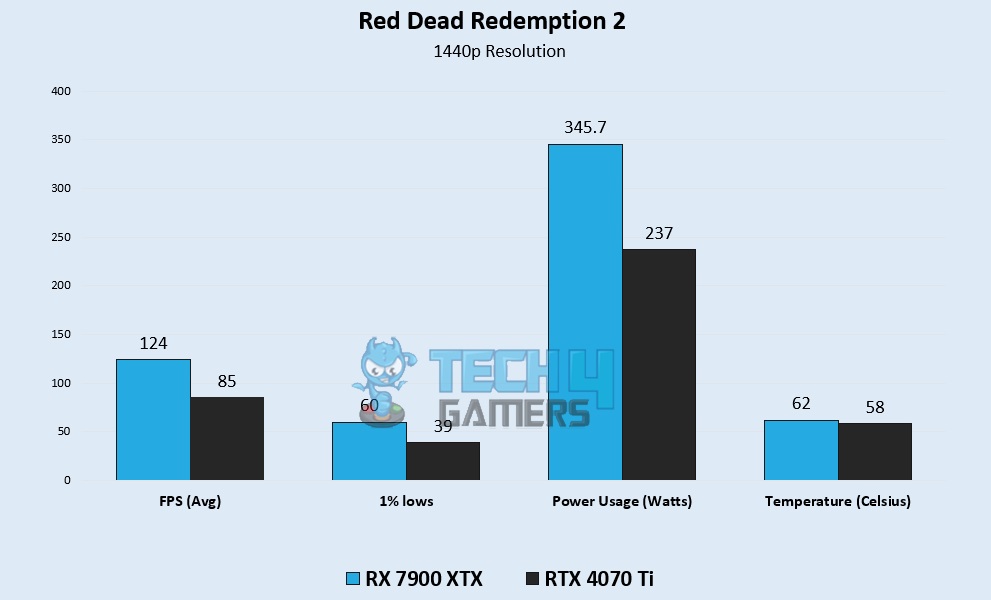
- Drawing from my testing, the RX 7900 XTX exhibits a commanding lead over the RTX 4080 Ti, with a significant 36% advantage when playing RDR2. The GPU provides an impressive average of 124 FPS, whereas Team Blue offers 86 FPS.
- When considering the 1% lows, it’s evident that the RX 7900 XTX maintains 60 FPS, while the RTX 4070 Ti falls behind with 39 FPS.
Assassin’s Creed Valhalla
![Assassin's Creed Valhalla 2K Gaming Benchmarks – Image Credits [Tech4Gamers]](https://tech4gamers.com/wp-content/uploads/2023/02/Assassins-Creed-Valhalla-2K-Gaming-Benchmarks-–-Image-Credits-Tech4Gamers.jpg)
- Based on my evaluation, the RX 7900 XTX takes a clear lead in this RTX 4070 Ti vs. RX 7900 XTX benchmark, offering a substantial 13% FPS boost with an average of 130 FPS. In comparison, the RTX 4070 Ti provides 114 FPS.
- Similarly, my observations in the 1% lows category echoed this trend, with the RX 7900 XTX maintaining a solid 60 FPS, just slightly ahead of the RTX 4070 Ti, which managed 61 FPS.
Horizon Zero Dawn
![Horizon Zero Dawn 2K Gaming Benchmarks – Image Credits [Tech4Gamers]](https://tech4gamers.com/wp-content/uploads/2023/02/Horizon-Zero-Dawn-2K-Gaming-Benchmarks-–-Image-Credits-Tech4Gamers.jpg)
- In my own hands-on testing, it’s no surprise that the RX 7900 XTX stands out with an impressive 14.2% improvement in FPS. It consistently delivers better average FPS counts, reaching 180 FPS compared to the RTX 4070 Ti’s 156 FPS.
- When focusing on the 1% lows, it’s interesting to note that both the RX 7900 XTX and RTX 4070 Ti perform equally, generating 51 FPS.
Doom Eternal (Ray Tracing ON)
![Doom Eternal (Ray Tracing ON) 2K Gaming Benchmarks – Image Credits [Tech4Gamers]](https://tech4gamers.com/wp-content/uploads/2023/02/Doom-Eternal-Ray-Tracing-ON-2K-Gaming-Benchmarks-–-Image-Credits-Tech4Gamers.jpg)
- Once again, in my own direct testing, I observed that the RTX 4070 Ti manages to provide more FPS than the RX 7900 XTX, offering a noteworthy 7% FPS boost with an average of 278 FPS, whereas the RX 7900 XTX achieves 259 FPS.
- However, it’s interesting to note that, in contrast to the average FPS, the RX 7900 XTX excels in 1% lows, consistently delivering 138 FPS, outperforming the RTX 4070 Ti’s 107 FPS.
Forza Horizon 5 (Ray Tracing Extreme)
![Forza Horizon 5 (Ray Tracing Extreme) 2K Gaming Benchmarks – Image Credits [Tech4Gamers]](https://tech4gamers.com/wp-content/uploads/2023/02/Forza-Horizon-5-Ray-Tracing-Extreme-2K-Gaming-Benchmarks-–-Image-Credits-Tech4Gamers.jpg)
- Both GPUs, according to my gaming experience, provide quite similar results here. The RX 7900 XTX shows a 3.5% FPS production boost by showing an average of 115 FPS, while the other offers 111 FPS.
- Additionally, when it comes to 1% lows, the RX 7900 XTX produces 79 FPS, while the RTX 4070 Ti produces 55 FPS.
Watch Dogs Legion (Ray Tracing Ultra)
![Watch Dogs Legion (Ray Tracing Ultra) 2K Gaming Benchmarks – Image Credits [Tech4Gamers]](https://tech4gamers.com/wp-content/uploads/2023/02/Watch-Dogs-Legion-Ray-Tracing-Ultra-2K-Gaming-Benchmarks-–-Image-Credits-Tech4Gamers.jpg)
- The RX 7900 XTX gains a slight edge over the RTX 4070 Ti in this game, as per my observation, and offers a 15% improved FPS production rate. It produces an average of 78 FPS compared to 67 FPS.
- Furthermore, I noticed that the 1% lows show similar results. You can see the RX 7900 XTX producing 60 FPS and the RTX 4070 Ti generating 44 FPS.
Cyberpunk 2077 (Ray Tracing Ultra)
![Cyberpunk 2077 (Ray Tracing Ultra) 2K Gaming Benchmarks – Image Credits [Tech4Gamers]](https://tech4gamers.com/wp-content/uploads/2023/02/Cyberpunk-2077-Ray-Tracing-Ultra-2K-Gaming-Benchmarks-–-Image-Credits-Tech4Gamers.jpg)
- Again, surprisingly, the RX 7900 XTX is falling behind with a 14.7% decrease in FPS production. It provides 63 FPS in comparison to 73 FPS on RTX 4070 Ti.
- Regarding the 1% lows, the RX 7900 XTX generates 50 FPS. Meanwhile, RTX 4070 Ti is producing 49 FPS.
Overall Gaming Performance
![Overall Gaming Performance – Image Credits [Tech4Gamers]](https://tech4gamers.com/wp-content/uploads/2023/02/Overall-Gaming-Performance-–-Image-Credits-Tech4Gamers.jpg)
Average Power Consumption
![Average Power Consumption – Image Credits [Tech4Gamers]](https://tech4gamers.com/wp-content/uploads/2023/02/Average-Power-Consumption-–-Image-Credits-Tech4Gamers.jpg)
Average Thermal Statistics
![Average Thermal Statistics – Image Credits [Tech4Gamers]](https://tech4gamers.com/wp-content/uploads/2023/02/Average-Thermal-Statistics-–-Image-Credits-Tech4Gamers.jpg)
Pricing And Availability
Since both of these cards come from the latest lineups from AMD and NVIDIA, it should be quite apparent that they can’t be considered budget-friendly. According to the MSRP, the Radeon RX 7900 XTX is available at a price tag of $999. On the other hand, the NVIDIA RTX 4070 Ti is being offered at $799.
In addition, it should be noted that the Radeon RX 7900 XTX is almost 22.2% more expensive than NVIDIA’s RTX 4070 Ti. Moreover, this gap may be further increased based on the variant and model.
RTX 4070 Ti Vs RX 7900 XTX: Which One Would I Recommend?
In my opinion and experience, after thoroughly testing these cards, It is without a doubt that both of these cards perform amazingly in their own way. So your decision to pick one of them would be based on your requirements only. However, I will help you recall some things that should make your decision easier.
When it comes to average FPS, the Radeon RX 7900 XTX takes the lead with an 11.6% improvement. But in terms of power consumption, the RTX 4070 Ti takes the cake. It provides itself by being a major 45% more power efficient.
Regarding thermal efficiency, NVIDIA’s RTX 4070 Ti is again in the lead. The card generates 14.8% less heat than the RX 7900 XTX. In addition, it is also found that the RTX 4070 Ti is almost 40% cheaper than its competition.
Therefore, I recommend you should consider whether you want a higher FPS count or more affordability. The RX 7900 XTX offers better performance. At the same time, the RTX 4070 Ti ensures you save your money wherever possible. In any case, I hope that my RTX 4070 Ti vs RX 7900 XTX comparison is going to help you choose the right GPU for your rig.
Pros And Cons
| GPU | Pros | Cons |
|---|---|---|
| RX 7900 XTX | New Architecture. Better Gaming Performance | Expensive Needs Bigger PSU |
| RTX 4070 Ti | Frame Generation Better Ray Tracing | Underwhelming performance. Not the best price-performance ratio. |
Frequently Asked Questions
There is no definite answer to this question, as both cards perform amazingly in their own ways. NVIDIA and AMD have put a lot of effort into their new lineups. Therefore, it is quite visible that it’s paying off.
As of this moment, the RTX 4090 is the latest card added to the RTX 4000 lineup. The card boasts a whooping 24GB of GDDR6X memory, along with many other features. This includes functionality like the DLSS 3.0 to boost its performance.
NVIDIA uses the abbreviation Ti for Titanium; these cards are usually released after the base versions are out. Some of these include RTX 4070 Ti, RTX 3090 Ti, RTX 3080Ti, etc.
More from RX 7900 XT:
- RX 7900 XT Vs RTX 3080 Ti: Which Is Better?
- RX 7900 XT Vs RTX 3080 [Gaming Benchmarks 2024]
- RX 7900 XT vs RTX 4080: Which Is Better?
More From RTX 4070 Ti:
Thank you! Please share your positive feedback. 🔋
How could we improve this post? Please Help us. 😔
[Comparisons Expert]
Abdemanaf is a skilled creative writer who has been honing his craft since 2011. While initially working in different fields, he found a passion for technology and has been exploring the tech world since early 2015. Over the years, he has developed an in-depth knowledge of the latest tech trends and product offerings by various companies.
Abdemanaf’s writing reflects his analytical mindset and ability to think critically. He has a knack for breaking down complex technical information into easily digestible pieces, making his articles engaging and accessible to readers from all backgrounds. In February 2022, he joined Tech4Gamers as a blog and product comparison writer, where he has been able to hone his skills further.
As a writer, Abdemanaf is dedicated to staying up-to-date with the latest technological advancements and trends, enabling him to provide readers with the most relevant and accurate information. He is always eager to learn more and is constantly seeking new challenges to improve his skills.
Get In Touch: manaf@tech4gamers.com


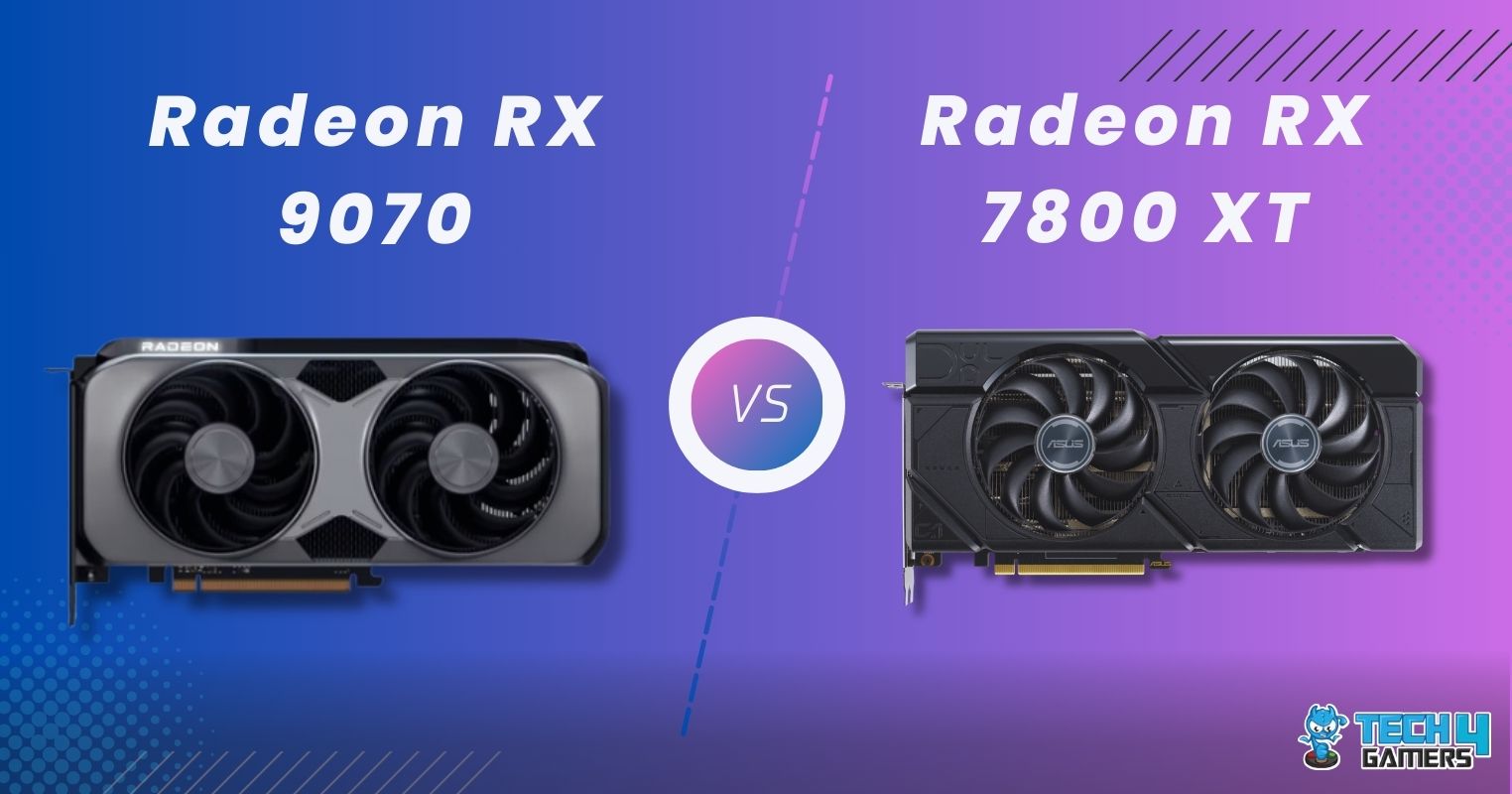
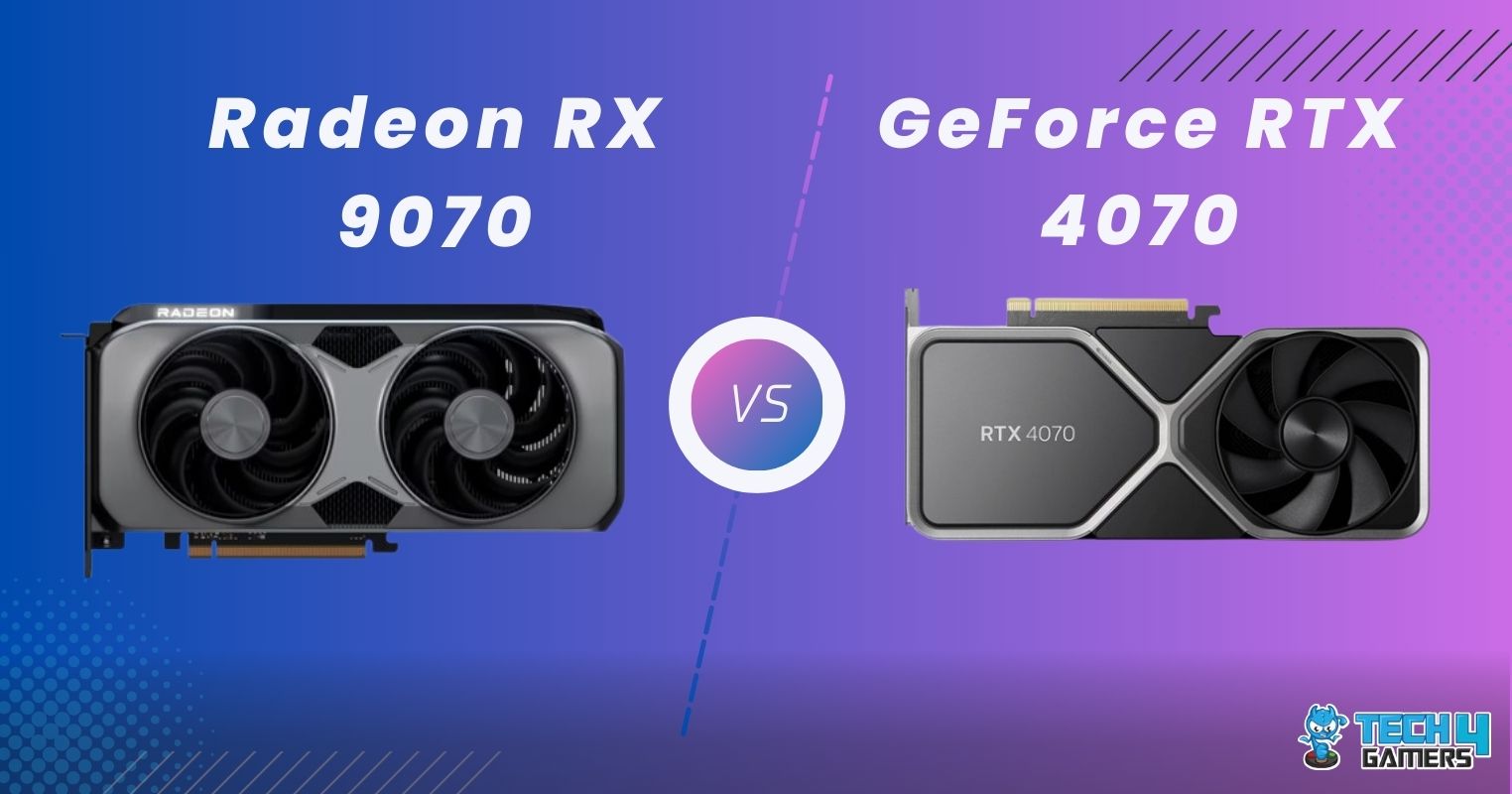
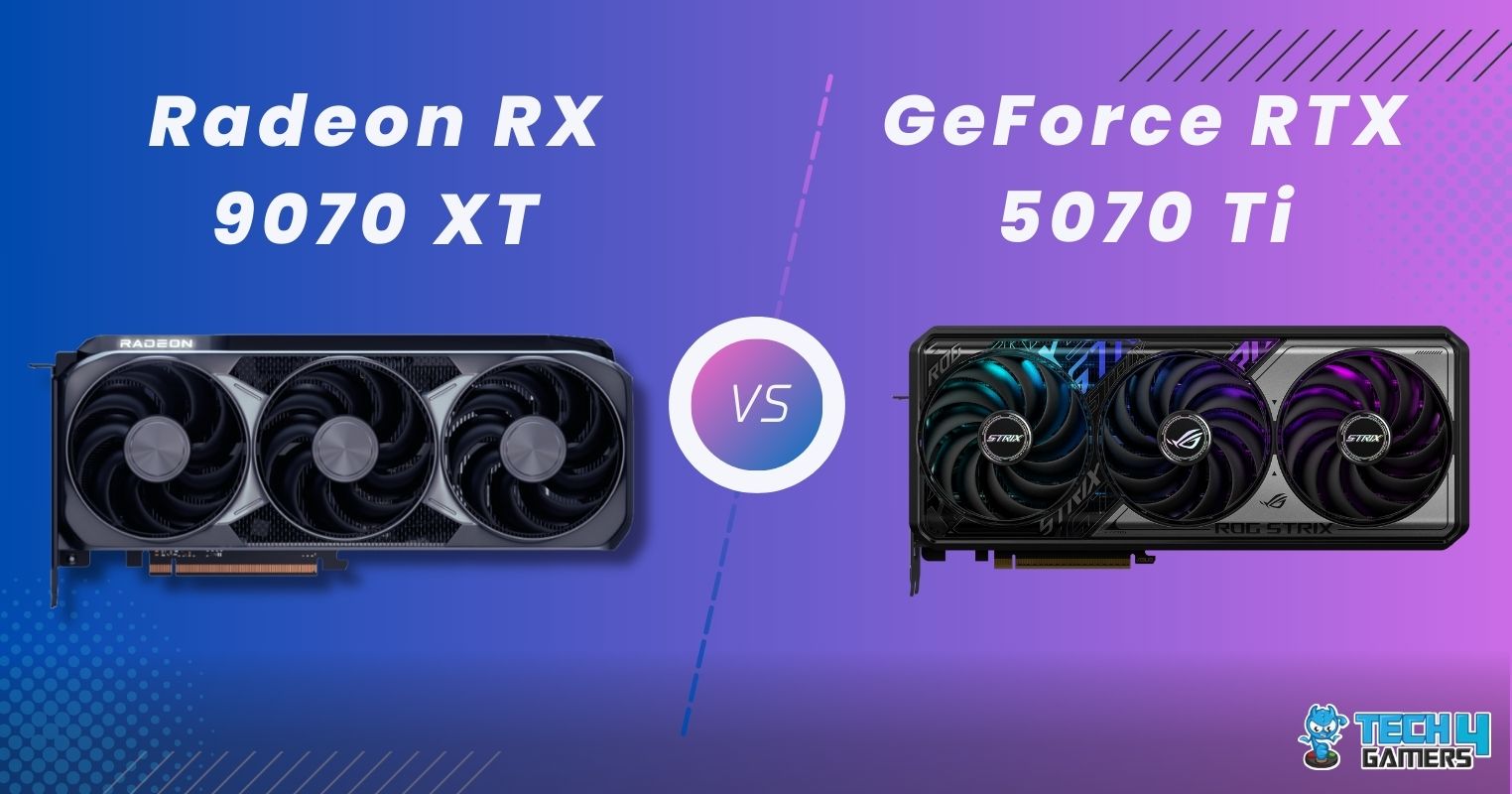
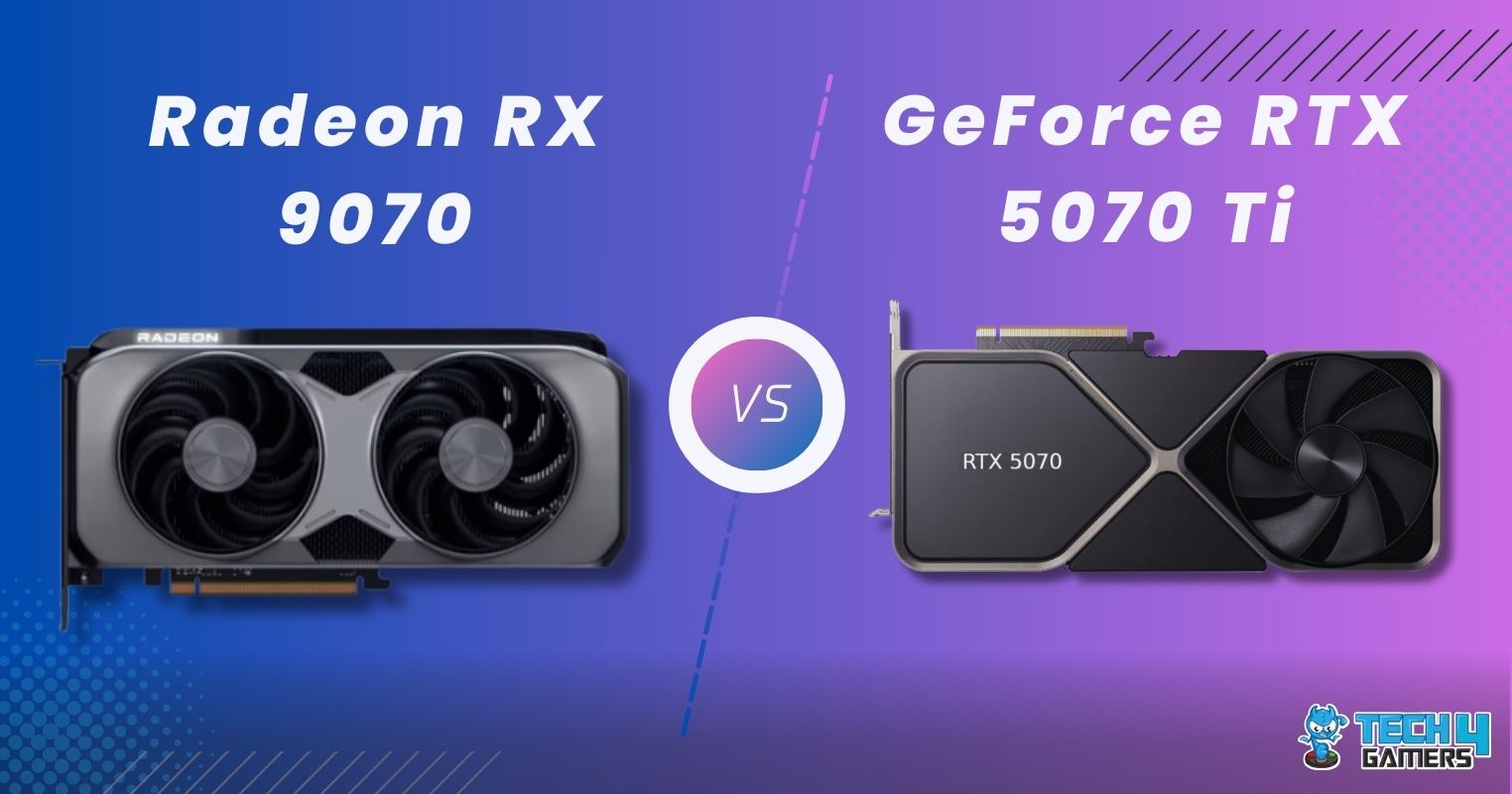
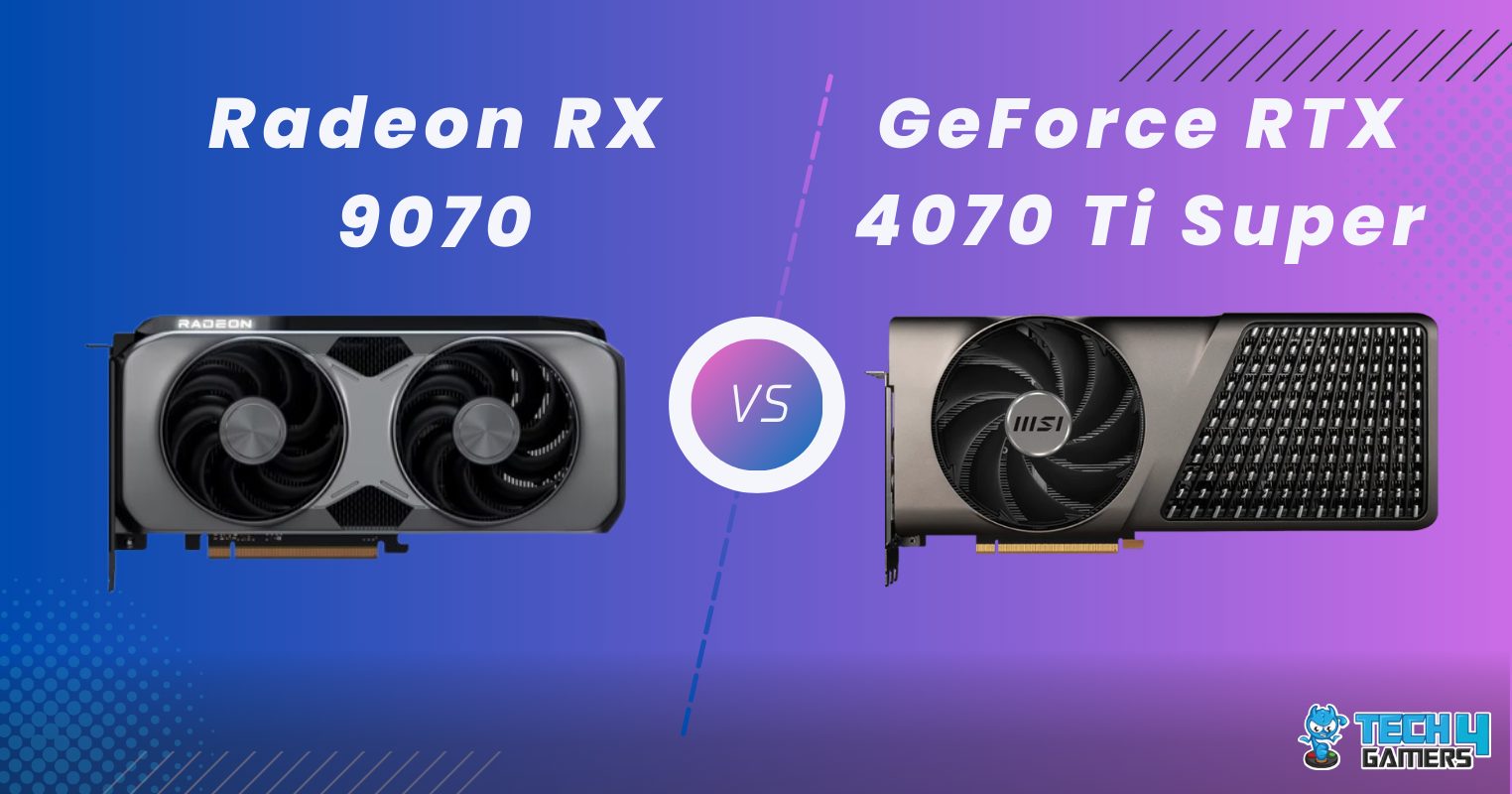
Feedback By: